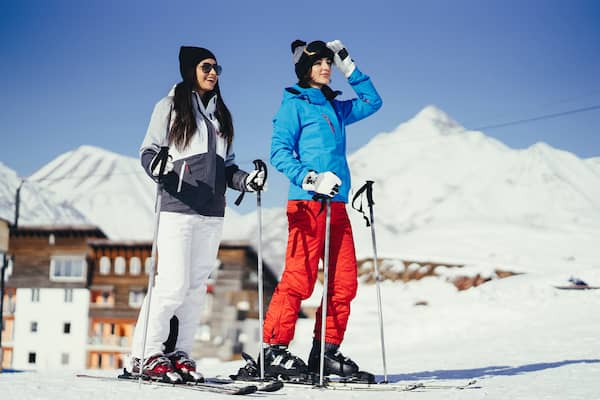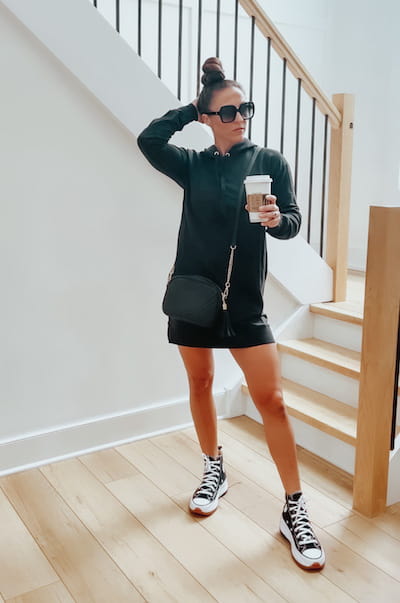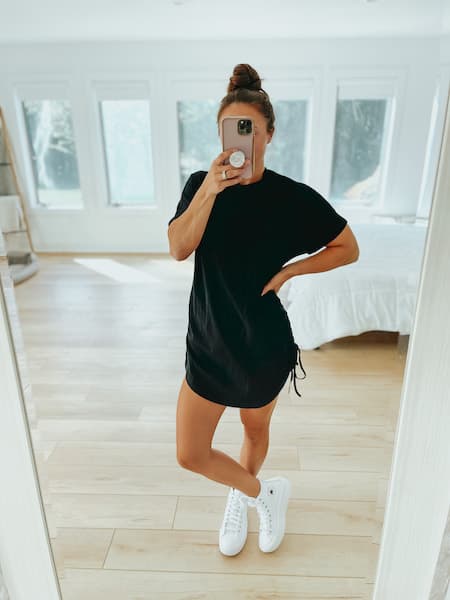What To Wear Under Ski & Snow Pants: Ultimate Guide
Are you planning a ski trip and wondering what to wear under your ski pants?
Dressing appropriately for the snow is important to making sure you’re not only warm but comfortable as well while hitting the slopes.
Wearing the right layers under your ski pants is just as important as ensuring you’ve packed your jacket and gloves!
So what exactly should you wear under your snow pants for the best, most comfortable skiing experience?
Let’s get into it.
What to Wear Under Snow Pants
As we know, one of the most crucial components of your ski outfit is what you wear under your ski pants.
These are some excellent base layers to choose from:

Long Underwear or Long Johns
Long underwear, commonly referred to as thermal underwear, is a classic choice for layering under a pair of ski pants.
They’re most often made from synthetic materials or wool, which will keep you both warm and dry.
It’s best to look for styles that fit snugly but aren’t too tight, so you’re comfortable and can move freely.

Thermal Underwear
The terms thermal underwear and long underwear are often used interchangeably.
However, although thermal underwear is similar to long underwear, it’s made from a thicker material to provide extra warmth.

Compression Pants
If you want a tighter fit than long underwear, try compression pants.
These stretchy pants hug your body and provide support for your muscles which is an added benefit.
They’re also made from breathable fabrics and are quick-drying, making them a perfect insulation layer.

Workout or Gym Leggings
Your favorite pair of workout pants is actually a great option as a base layer bottom because they are thin, comfortable, and designed to wick moisture.
They will also help to retain your body heat keeping you warm on cold days.
It has to be said but while cotton leggings may seem like a comfortable option, they’re not the best choice for skiing.
Cotton holds onto moisture, which can make you feel damp and cold so it’s definitely a good idea to choose a pair made of a different material.
The best thing about wearing your workout leggings is that you likely already have a pair you know and love!

Fleece Leggings
Fleece leggings are a cozy option for your first layer.
Made from synthetic materials, fleece leggings are soft and warm.
They’re also moisture-wicking, making them a good choice for active skiing.
Types of Snow Pants
So now that we’ve covered what to wear under your snow pants, let’s chat about what types of snow pants there are to choose from.
Each type has its own advantages and disadvantages, so it’s important to choose the one that’s best for your needs.
Here are the most common types of snow pants:

Insulated Ski Pants
Insulated ski pants are designed to keep you warm in cold weather.
They have a layer of insulation built into the pants, which helps to trap body heat and keep you warm.
These pants are great for skiing in colder climates but may be too warm for milder temperatures.
Insulated ski pants come in both bib and regular pant styles.

Hard Shell Ski Pants
These ski pants are often crafted from materials like Gore-Tex.
They are designed for maximum protection against harsh weather conditions such as wind and snow.
While their durability and weather resistance are definite advantages, the trade-off is that they are slightly stiffer and less flexible compared to soft shell options.
They are also not as breathable as other options which can quickly raise your body temperature.

Softshell Ski Pants
Softshell ski pants are all about flexibility and comfort while on the slopes.
They are made from a stretchy, breathable material that is designed to move with your body.
They are typically less bulky than insulated or hard outer shell pants, which makes them a good choice for skiers who prefer a more relaxed and looser fit.
However, they don’t offer the same waterproof and windproof protection that the hardshell pants do.
This type of shell pant is generally better for milder skiing conditions – unless you layer appropriately.

Bib Ski Pants
A ski bib is a very popular choice for skiers who want extra protection from the snow.
This design is likely what you think of when you think “ski pants” as they have a bib that goes over your chest, which helps to keep snow out of your pants.
These overall type pants also provide extra warmth and protection for your core.
Bibs come in both insulated and shell styles.

Consider the Skiing Weather Conditions
The weather conditions will have the biggest impact on what you should wear skiing to keep warm, dry, and comfortable!
Here are some tips for dressing appropriately for different skiing weather conditions:
Cold Weather
If you’re skiing in cold weather, you’ll want to dress in layers to stay warm.
Start with a base layer made of a moisture-wicking material like merino wool leggings or something made of a synthetic fabric.
This will help keep sweat away from your skin, which can make you feel colder.
Then add an extra layer like fleece or down for more insulation and added warmth.
Finish with a waterproof and breathable outer layer to protect you from wind and snow.
Warm Weather
On warmer sunny days, you’ll want to dress in lighter layers to stay comfortable.
A lightweight base layer made of a breathable material will help keep you cool and dry but not too warm.
Pair this with another lightweight insulating layer like a softshell jacket, and finish with, you guessed it, a waterproof and breathable outer layer to protect you from any unexpected rain or snow.
Windy Weather
You’ll definitely want to take any wind in the forecast into account – wind can make even mild temperatures feel so much colder.
While you’ll start with base layer pants and potentially a mid-layer based on the temperature, you’ll definitely want to top it off with a windproof and waterproof outer layer to protect you from the elements.
Snowy Weather
This is where you really want to focus on layers that will keep you warm and dry.
You might consider synthetic base layers and mid-layers of thicker material as well as thick outer layers that provide insulation and waterproof material from active snowfall.

Choosing the Right Material
When it comes to choosing the right material for your base layer to wear under ski pants, there are a few things to consider.
The two main types of materials are synthetic materials, like polyester, and natural materials, such as merino wool and cotton.
Both have their pros and cons, and it’s important to choose the right one for your day in the snow to keep you warm and comfortable.
Merino Wool
Merino wool is one of the most popular choices for base layers and for good reason.
It’s a natural fabric that’s soft, warm, and comfortable to wear.
A merino wool base layer wicks moisture away from your skin, keeping you dry and warm even when you’re sweating – which will definitely be the case while skiing or snowboarding.
Merino base layers are also naturally odor-resistant, so you don’t have to worry about them smelling bad after a long day on the slopes.
Lastly, this is the best option for people with sensitive skin because merino wool is hypoallergenic.
Polyester
Polyester is a synthetic fabric that’s often used as an inner layer (such as leggings) because of its moisture-wicking properties.
It’s also a breathable fabric that is quick-drying, making it a good option for any active sports.
Polyester fabrics can also be blended with other synthetic fibers, like elastane or spandex, to give them some extra stretch- making them even more comfortable with a greater range of motion.
Silk
Silk is a natural material that’s been used for centuries for its softness and warmth.
It’s an excellent choice for people with sensitive skin because it’s hypoallergenic and doesn’t irritate the skin.
Silk base layers are also lightweight and breathable, making them a good choice for warmer days on the slopes.
However, they’re not as moisture-wicking as other materials, so they may not be the best choice for people who sweat a lot.
Layering Tips for Skiing
Layering for Cold Conditions
If you’re skiing in cold conditions, I recommend having a base layer, a mid-layer, and an outer layer to help you keep warm.
For a good base layer, look for long underwear or leggings made from moisture-wicking materials like merino wool or synthetic fabrics.
On top of your base layer, add a mid-layer for extra insulation.

This might be a fleece or down jacket on your upper body – something to keep you warm even in the coldest conditions.
Finally, you’ll add a waterproof and windproof shell as your outer layer.
On the bottom, this will be your ski pants and on the top, you’ll want a jacket with sealed seams to keep moisture out.
Layering for Warm Conditions
Layering is just as important if you’re skiing or snowboarding in warmer conditions as you can peel them off as needed.
In this case, you’ll want to focus on layers that will keep you cool and dry.
Start with a lightweight base layer that will keep sweat away from your skin.
Then add a lightweight mid-layer that will protect against the sun and add a bit of insulation if needed.
A long-sleeve shirt made from breathable fabric is a great option for this layer.
Finally, add a lightweight, breathable shell as your outer layer.
You might want to consider jackets and pants made from materials like Gore-Tex that will protect you from the sun and wind while still allowing air to circulate.
More Layers For Skiing

Ski Jacket
With all this talk about keeping your lower body warm, we can’t forget about your upper body!
Your ski jacket is an incredibly important layer for keeping warm and dry.
The must-have features when looking for a jacket?
One that is waterproof, windproof, and breathable.
For a cool day, you’ll want to consider something like a puffy jacket with enough insulation to keep you warm.
On a warm day, you can opt for a lighter jacket with a waterproof shell.
A good ski jacket will also have a hood to protect your head from the elements.

Face Mask
A face mask is essential for protecting your face from the cold and wind, especially on days when the weather is a bit more intense or in colder climates.
Look for a mask that is made of breathable material and covers both your nose and mouth.
Some masks also have a built-in neck warmer which is great for added warmth.

Ski Boots
Kind of obvious, right?
But your ski boots are another important layer for staying warm and comfortable.
Look for boots that fit well and are insulated.
They should also be waterproof to keep your feet dry.
Some boots also have a removable liner for added warmth or that you can remove if it’s a bit warmer.

Ski Socks
Wool socks or other ski socks are a must-have for skiing.
They provide extra warmth to your feet and toes and the fabric helps to keep your feet dry.
Look for socks that fit snugly but aren’t too tight, so you can move your feet and prevent them from falling asleep.

Ski Gloves
No matter what the weather conditions are, when spending time in the snow you’re going to want a good pair of ski gloves.
They are essential for keeping your hands warm and dry.
Again, look for gloves that are waterproof and insulated.
They should also be breathable to prevent your hands from getting too sweaty.
Having a wrist strap will help to keep them in place or falling off.
FAQs
What is the best base layer to wear under ski pants?
The best base layer to wear under ski pants is a moisture-wicking layer that will keep you dry and warm.
Look for base layers made of synthetic materials like polyester or merino wool.
It’s best to avoid cotton as it will hold in that moisture, making you feel cold and clammy.
Can I wear jeans or regular pants under my ski pants?
No, you should not wear jeans or regular pants under your ski pants.
Jeans and regular pants are made of cotton, which does not wick moisture away from your skin.
Not to mention jeans and regular pants are not designed to be worn as a base layer, so they will likely bunch and won’t fit comfortably under your ski pants.
Do you need a base layer under snow pants?
Yes, you should definitely wear a base layer under your snow pants.
A base layer will help keep you warm and dry by wicking moisture away from your skin.
Depending on the weather conditions and how warm it is you can choose a thicker or thinner pair or one made of warmer material.
How tight should ski pants be?
Ski pants should fit snugly but not be too tight – you want to be able to move comfortably without feeling restricted.
If your ski pants are too tight, not only will it restrict movement and make skiing or snowboarding more difficult but it’ll be really uncomfortable!
On the other hand, if your ski pants are too loose, they might not provide enough insulation, and you’ll find yourself freezing.
It’s important to find the right balance between comfort and insulation when choosing the perfect fit for your ski pants.
Conclusion
Whether it’s cross-country or backcountry skiing, you always want to be ready for the elements.
However, the different options we’ve provided are perfect choices for both warmth and comfort.
Just remember that the best materials for layering under ski pants are those that are quick drying, and moisture-wicking.
It’s always a good idea to bring a few options so you’re not stuck at your ski resort with clothes that don’t work for you.
At the end of the day, your choice of base layer is a personal preference, but the best way to ensure you have a great time is to be prepared!





